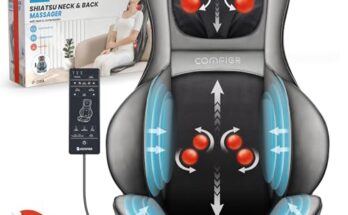Muscles hurt during massage due to the release of tension and toxins. When pressure is applied to muscles during a massage, it can lead to the breakdown of adhesions and the release of toxins, causing discomfort.
This discomfort is typically temporary and is a sign that the massage is effectively targeting areas of tension. Additionally, the pain can also be the result of muscle knots being worked out, leading to temporary soreness. It’s important to communicate with your massage therapist about your pain tolerance and preferences to ensure the most comfortable experience.
Understanding the reasons behind muscle pain during a massage can help individuals appreciate the benefits that come after the discomfort subsides.
The Science Behind Muscle Pain
Muscle pain during a massage is a common experience, and often leads people to question why their muscles hurt during a seemingly relaxing activity. Understanding the science behind muscle pain can help explain this discomfort and reassure individuals that it is a natural response to the therapeutic process.
Muscle Microtrauma
During a massage, the application of pressure to muscle tissues can lead to microtears in the muscle fibers, known as muscle microtrauma. This microtrauma occurs as a result of the stretching and manipulation of the muscle fibers, leading to small tears in the tissue. Although this may sound concerning, it is a natural response that promotes muscle growth and repair.
Inflammation And Healing Process
Following the microtrauma, the body triggers an inflammatory response to initiate the healing process. This inflammation can cause discomfort and pain, as the body’s immune system works to repair and strengthen the damaged muscle fibers. The resulting discomfort during a massage is a sign that the healing process is underway and the muscles are being rejuvenated.

Credit: utahtherapeuticmassage.com
Understanding Massage Techniques
Muscles can ache during a massage due to tension release and muscle manipulation. This discomfort is part of the process of improving circulation and relieving muscle tightness. Understanding these techniques can help you appreciate the benefits of massage therapy.
Understanding Massage Techniques Pressure and Friction During a massage, the application of pressure and friction plays a crucial role in providing relief to sore muscles. The specific techniques employed by the masseuse can either alleviate pain or worsen it if not performed correctly. Pressure refers to the force applied to the muscles, while friction involves the movement of the masseuse’s hands over the skin’s surface. Understanding how these techniques interact is essential for ensuring a beneficial and pain-free experience. Deep Tissue vs. Swedish Massage When it comes to massage techniques, two popular options are deep tissue and Swedish massage. Deep tissue massage targets the deeper layers of muscle and connective tissue, aiming to release chronic muscle tension. On the other hand, Swedish massage uses a gentler approach, focusing on relaxation and increasing blood circulation. Each technique has its benefits, so choosing the right one depends on the individual’s specific needs and preferences.Impact Of Knots And Tension
Muscle knots and tension can cause discomfort during a massage, affecting the overall experience. Understanding how knots form and the role tension plays in muscle pain can shed light on why muscles may hurt during a massage.
Formation Of Muscle Knots
- Muscle knots typically develop due to overuse or injury.
- Tight muscle fibers bunch up, forming a knot that restricts blood flow.
- This leads to localized pain in specific areas of the body.
Releasing Tension Through Massage
- Massage helps relax tense muscles and break down knots.
- Techniques like kneading and friction target knots to release tension.
- Improved blood flow aids in the healing process.

Credit: www.facebook.com
Benefits Of Painful Massages
While the idea of a painful massage may seem counterintuitive, it actually offers several benefits that can improve your overall well-being. The discomfort you may experience during a massage is often a sign that your muscles are being worked on effectively. In this blog post, we will explore three key benefits of painful massages: improved blood circulation, enhanced muscle recovery, and release of tension. Let’s dive right in!
Improved Blood Circulation
One of the primary benefits of a painful massage is the improved blood circulation it provides. As a massage therapist applies pressure to your muscles, it stimulates the blood vessels in that area, causing them to dilate. This increase in blood flow not only delivers more oxygen and nutrients to your muscles but also helps remove waste products, like lactic acid, that can lead to muscle fatigue and soreness. So, even though a painful massage may cause some temporary discomfort, it ultimately promotes better blood circulation, leaving you feeling rejuvenated and revitalized.
Enhanced Muscle Recovery
Another advantage of enduring a painful massage is its ability to enhance muscle recovery. During a deep tissue or sports massage, the therapist targets specific areas of tension and applies intense pressure to break up knots and adhesions in the muscles. This deep pressure stimulates the muscle fibers, promoting efficient healing and repair. It also helps reduce inflammation and swelling, speeding up the recovery process. So, while the discomfort may be temporary, the long-term benefits include improved muscle function and reduced risk of future injuries.
Release Of Tension
Painful massages also provide the much-needed release of tension in your muscles and soft tissues. When stress and tension build up in your body, it can lead to muscle stiffness and restricted movement. By applying deep pressure during a massage, the therapist can help alleviate this tension and improve your flexibility and range of motion. The discomfort you feel during the massage is a sign that the therapist is effectively targeting and releasing the knots and tightness in your muscles. As a result, you’ll experience a greater sense of relaxation and relief after the session.
Tips For Managing Post-massage Discomfort
Experience discomfort after a massage? It’s normal. Muscles can feel sore due to the release of built-up tension during the massage. This discomfort is temporary and can be managed through gentle movements, staying hydrated, and using ice or heat therapy.
Hydrate And Rest
After a rejuvenating massage, it’s important to prioritize your body’s needs by giving it ample rest and hydration. Hydrating your body can help flush out toxins released during the massage, while rest allows your muscles to recover and heal. Drinking plenty of water after your session helps replenish lost fluids and supports optimal muscle function. Make sure to rest and give your body the time it needs to fully recover.Heat Or Cold Therapy
As part of your post-massage routine, consider incorporating heat or cold therapy to relieve any discomfort or soreness. Applying a hot compress or taking a warm bath can help relax your muscles, increase blood circulation, and promote overall relaxation. Heat therapy is particularly beneficial for reducing muscle tension and soothing any inflammation. On the other hand, if you’re experiencing swelling or acute pain, applying a cold compress or ice pack can help minimize inflammation and provide immediate relief. It’s essential to listen to your body and choose what feels best for you. Remember to use heat therapy for relaxing muscles and cold therapy for reducing inflammation and acute pain. Your well-being is essential, and taking care of your body after a massage is a crucial part of the self-care process. Hydrating your body and allowing it to rest will promote healing, while heat therapy can provide relaxation and improve muscle function. Similarly, cold therapy can reduce inflammation and alleviate acute pain. Prioritize these tips for managing post-massage discomfort, and you’ll ensure a smoother recovery process, bringing you closer to experiencing the full benefits of your therapeutic massage.
Credit: healthnews.com
Frequently Asked Questions On Why Do Muscles Hurt During Massage
Is It Ok To Feel Pain During Massage?
Feeling mild discomfort during a massage can be normal due to muscle tension release. However, if the pain is excessive or causes distress, inform your therapist immediately for adjustments. Effective communication is key to ensure a comfortable massage experience.
Can A Massage Therapist Feel Knots?
Yes, a skilled massage therapist can feel knots through touch and experience, helping to release tension and improve mobility.
Why Do Massages Hurt Then Feel Good?
Massages can hurt initially due to deep pressure and releasing muscle tension. However, the discomfort is generally followed by a sense of relief and relaxation caused by increased blood flow, reduced inflammation, and the release of endorphins.
What Are The Tender Spots During A Massage?
Tender spots during a massage are sensitive areas that can be painful or uncomfortable when pressure is applied. These spots can vary from person to person and may include tight muscles, knots, or areas of inflammation. Massaging these spots can help relieve tension and improve overall well-being.
Conclusion
Muscles can hurt during a massage due to tension release and lactic acid buildup. It’s a normal part of the healing process. Proper hydration and rest can help alleviate soreness post-massage. Understanding why muscles ache can enhance your massage experience and overall well-being.
So, embrace the discomfort for a healthier body.


